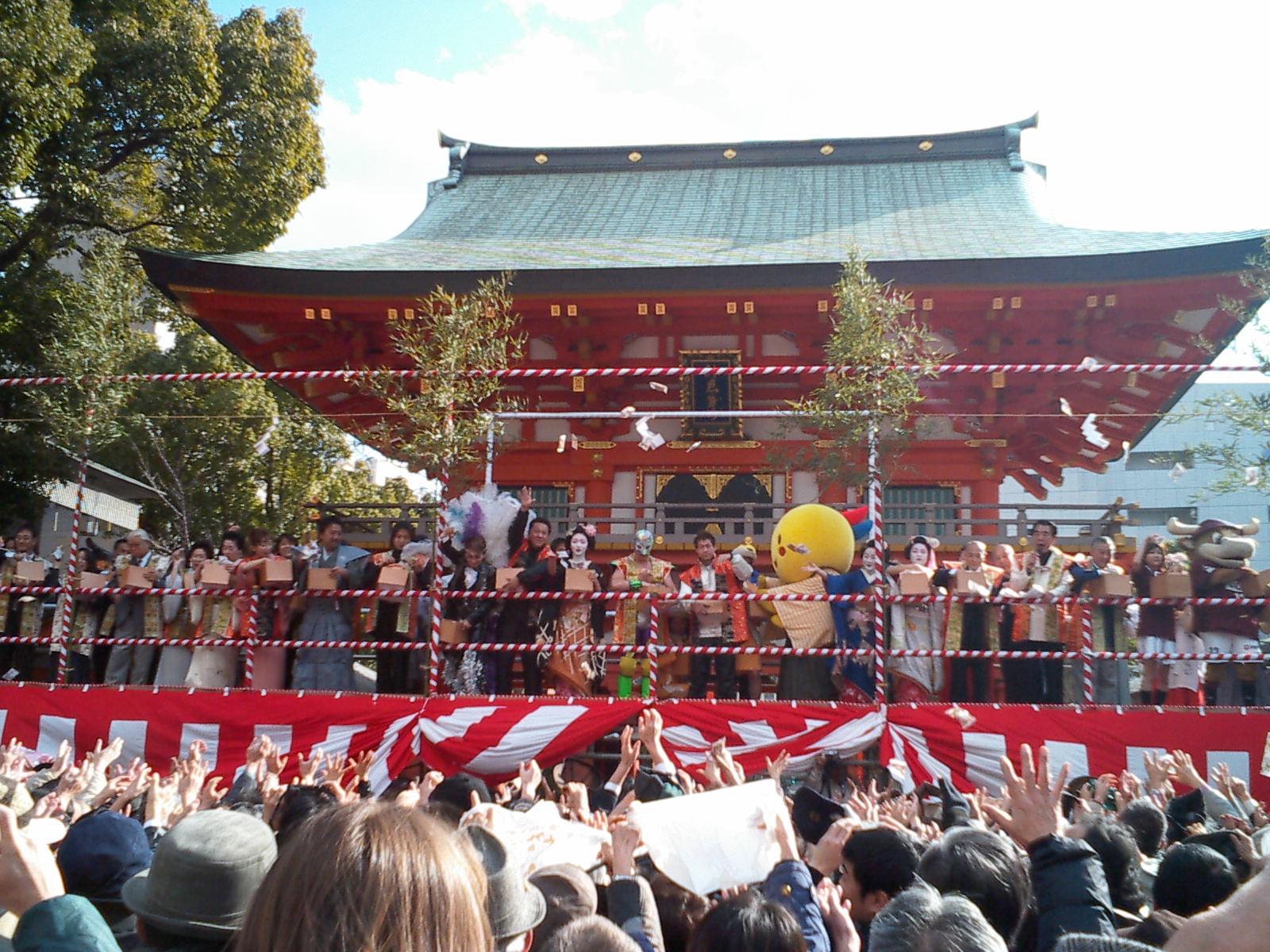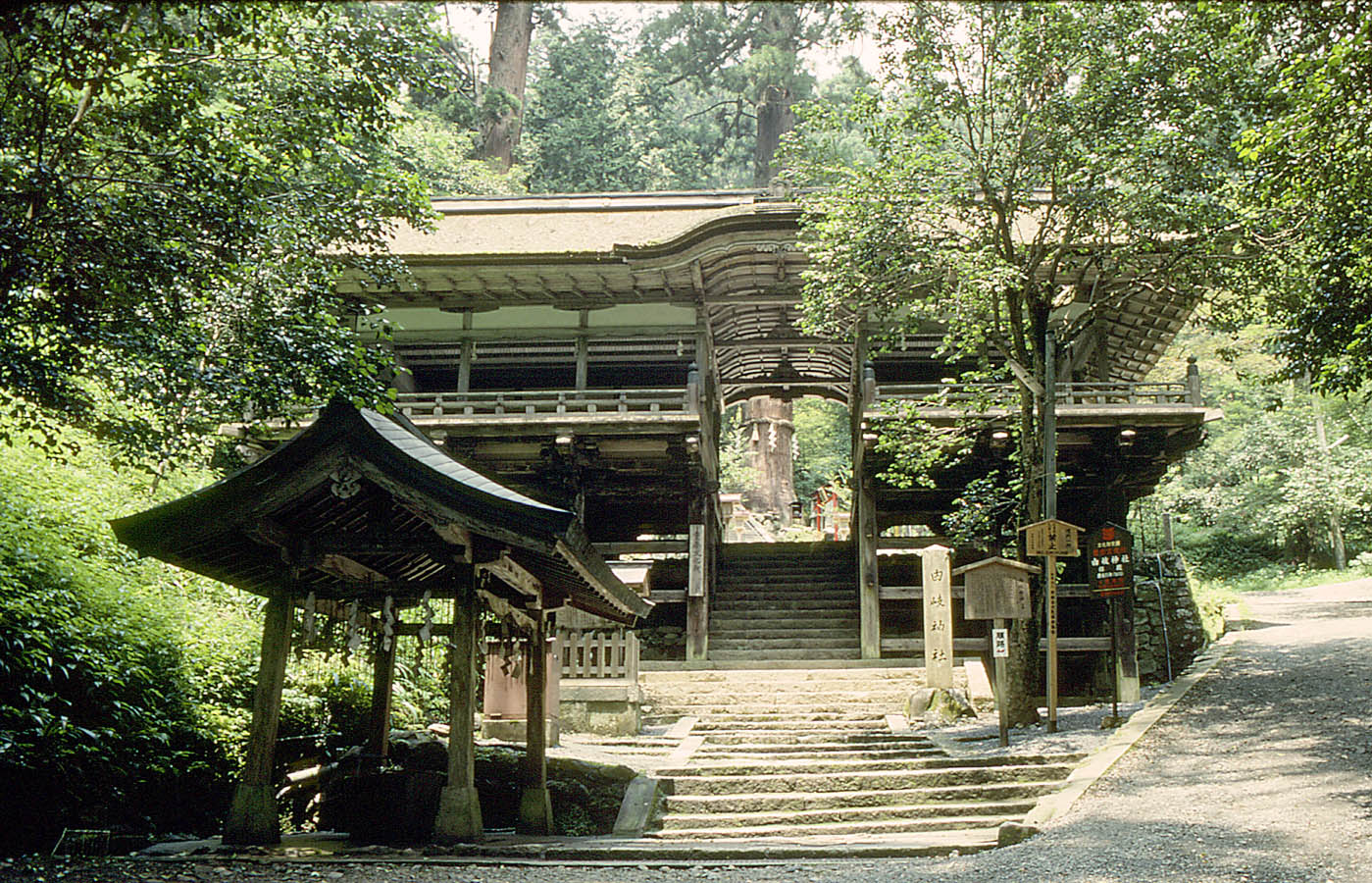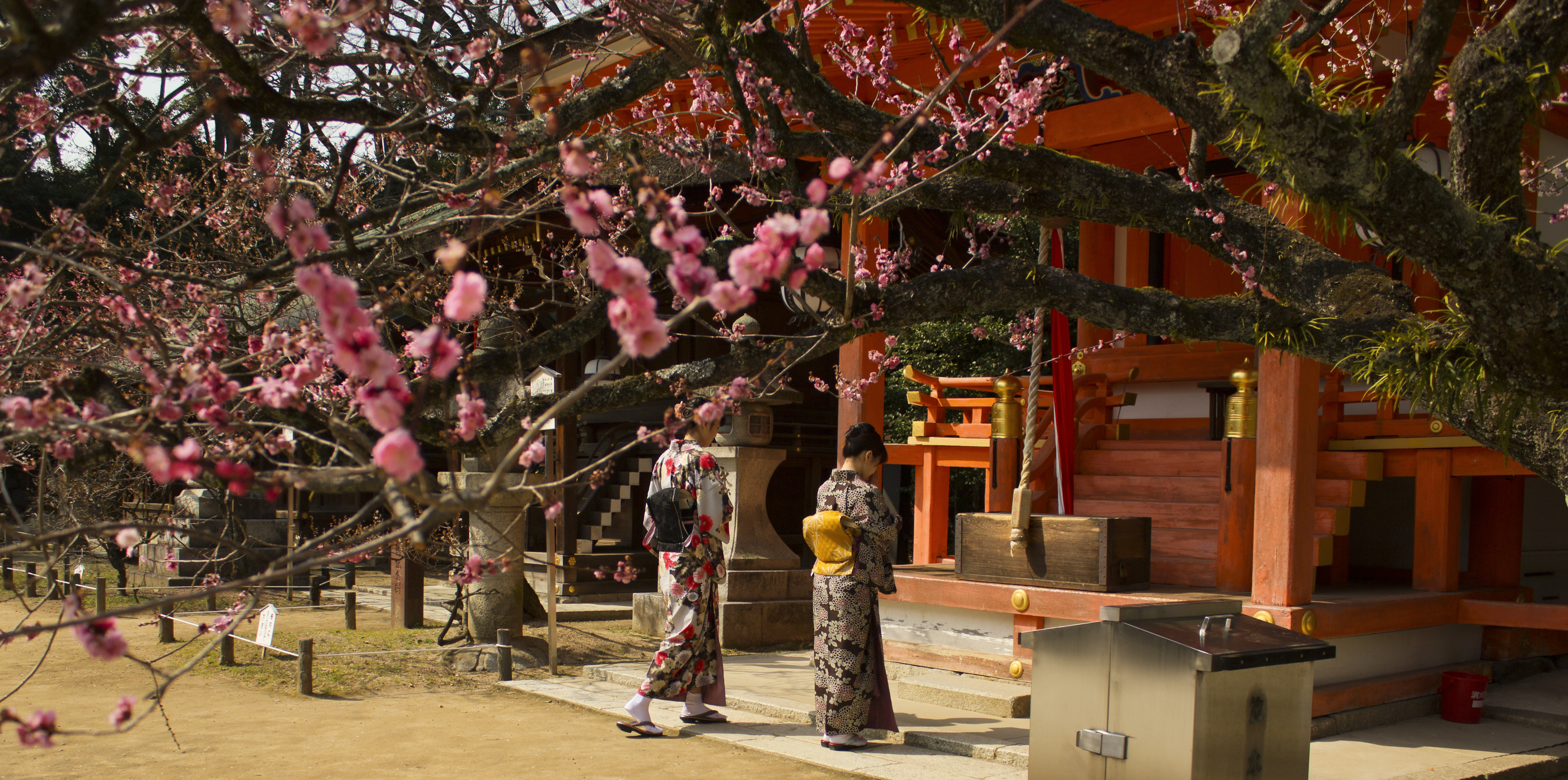|
Setsubun
is the day before the beginning of spring in the old calendar in Japan. The name literally means 'seasonal division', referring to the day just before the first day of spring in the traditional calendar, known as ; though previously referring to a wider range of possible dates, is now typically held on February 3 (in 2021 and 2025 it was on 2nd February), with the day after – the first day of spring in the old calendar – known as . Both and are celebrated yearly as part of the Spring Festival () in Japan. was accompanied by a number of rituals and traditions held at various levels to drive away the previous year's bad fortunes and evil spirits for the year to come. History has its origins in , a Chinese custom introduced to Japan in the 8th century. It was quite different from the known today. According to the Japanese history book , was first held in Japan in 706, and it was an event to ward off evil spirits held at the court on the last day of the year accord ... [...More Info...] [...Related Items...] OR: [Wikipedia] [Google] [Baidu] [Amazon] |
Japanese Calendar
Japanese calendar types have included a range of official and unofficial systems. At present, Japan uses the Gregorian calendar together with year designations stating the Japanese era name, year of the reign of the current Emperor. The written form starts with the year, then the month and finally the day, coinciding with the ISO 8601 standard. For example, February 16, 2003, can be written as either or (the latter following the regnal year system). reads and means "year", reads and means "month", and finally (usually) reads (its pronunciation depends on the number that precedes it, see below) and means "day". Prior to the introduction of the Gregorian calendar in 1873, the reference calendar was based on the lunisolar Chinese calendar. History File:Briefly_Abridged_Calendar_of_1873%2C_Hiroshige_Museum_of_Art.JPG, Briefly Abridged Calendar of 1873 File:Calendar_for_1907%2C_Nakai_Tokujiro_%28Pub.%29%2C_Hiroshige_Museum_of_Art.JPG, Calendar for 1907 Over the centuries, ... [...More Info...] [...Related Items...] OR: [Wikipedia] [Google] [Baidu] [Amazon] |
立春
The traditional Chinese calendar divides a year into 24 solar terms. The first one is known as in Chinese, in Japanese, in Korean, and in Vietnamese. It begins when the Sun reaches the celestial longitude of 315° and ends when it reaches the longitude of 330°. It more often refers in particular to the day when the Sun is exactly at the celestial longitude of 315°. In the Gregorian calendar, it usually begins around February 4 and ends around February 18 (February 19 East Asia time). It is also the beginning of a sexagenary cycle. Lichun signifies the beginning of spring in East Asian cultures. Pentads Each solar term can be divided into 3 pentads (候). They are: first pentad (初候), second pentad (次候) and last pentad (末候). Pentads in Lichun include: ; China * First pentad: Dōng Fēng Jiě Dòng () *: '' Yuè Lìng Qī Shí Èr Hòu Jí Jiě'' (月令七十二候集解) explains the name of this pentad:It is not called the 'winter ice meets the spring wind ... [...More Info...] [...Related Items...] OR: [Wikipedia] [Google] [Baidu] [Amazon] |
Lichun
The traditional Chinese calendar divides a year into 24 solar terms. The first one is known as in Chinese, in Japanese, in Korean, and in Vietnamese. It begins when the Sun reaches the celestial longitude of 315° and ends when it reaches the longitude of 330°. It more often refers in particular to the day when the Sun is exactly at the celestial longitude of 315°. In the Gregorian calendar, it usually begins around February 4 and ends around February 18 (February 19 East Asia time). It is also the beginning of a sexagenary cycle. Lichun signifies the beginning of spring in East Asian cultures. Pentads Each solar term can be divided into 3 pentads (候). They are: first pentad (初候), second pentad (次候) and last pentad (末候). Pentads in Lichun include: ; China * First pentad: Dōng Fēng Jiě Dòng () *: '' Yuè Lìng Qī Shí Èr Hòu Jí Jiě'' (月令七十二候集解) explains the name of this pentad:It is not called the 'winter ice meets the spring win ... [...More Info...] [...Related Items...] OR: [Wikipedia] [Google] [Baidu] [Amazon] |
National Institute Of Japanese Literature
The , or NIJL, was established in May 1972. Its primary purpose is to preserve manuscripts and books relating to the study of Japanese literature Japanese literature throughout most of its history has been influenced by cultural contact with neighboring Asian literatures, most notably China and its literature. Early texts were often written in pure Classical Chinese or , a Chinese-Japa .... Original texts and microfilms of these originals are stored in the institute's archives, although a project is underway to make digital copies of all these materials. The NIJL provides several useful tools for the scholar of Japanese literature, including a compilation of research published yearly in the journal ''Kokubungaku Nenkan'' (国文学年刊). It has also developed several on-line databases. History of the Institute In 1966, the Convention of Japanese Scholarship advised the government of Japan to found what at the time was referred to as 'Center for Japanese studies and Japanese ... [...More Info...] [...Related Items...] OR: [Wikipedia] [Google] [Baidu] [Amazon] |
Emperor Uda
was the 59th emperor of Japan,Imperial Household Agency (''Kunaichō'') 宇多天皇 (59)/ref> according to the traditional order of succession. Uda's reign spanned the years from 887 through 897. Traditional narrative Name and legacy Before his ascension to the Chrysanthemum Throne, his personal name (''imina'') was or ''Chōjiin-tei''. Emperor Uda was the third son of Emperor Kōkō. His mother was Empress Dowager Hanshi, a daughter of Prince Nakano (who was himself a son of Emperor Kanmu). Uda had five Imperial consorts and 20 Imperial children.Brown, p. 289. Particularly important sons include: * Prince Atsuhito (884–930) * Prince Atsuzane (893–967) Historical background In ancient Japan, there were four noble clans, the '' Gempeitōkitsu'' . One of these clans, the Minamoto clan , is also known as Genji. Some of Uda's grandchildren were granted the surname ''Minamoto'', the most used surname for former Japanese royalty. In order to distinguish Uda's descen ... [...More Info...] [...Related Items...] OR: [Wikipedia] [Google] [Baidu] [Amazon] |
Mount Kurama
is a mountain to the north of the Japanese city of Kyoto. It is the birthplace of the Reiki practice, and is said to be the home of Sōjōbō, King of the Tengu. Kurama is also the location of the annual , which takes place every October. is now designated as a national treasure of Japan. Great-Tengu Sōjōbō was supposedly the Tengu who taught swordsmanship to Minamoto no Yoshitsune. The philosopher Hayashi Razan lists one of the three greatest of the ''tengu, daitengu'' as Sōjōbō of Mount Kurama. The demons of Kurama and Atago are among the most famous ''tengu''. Holistic healing The mountain is also known as the birthplace of the holistic healing art called Reiki. In 1922 the founder of Reiki, Mikao Usui, meditated for 21 days on this mountain and received the Reiki healing energy and was said to have become an enlightened person and to have gained true insight into the wisdom of life. Mikao Usui meditated near the top of the mountain at a site called Osugi Gongen, ... [...More Info...] [...Related Items...] OR: [Wikipedia] [Google] [Baidu] [Amazon] |
Mie Prefecture
is a Prefectures of Japan, prefecture of Japan located in the Kansai region of Honshu. Mie Prefecture has a population of 1,781,948 () and has a geographic area of . Mie Prefecture is bordered by Gifu Prefecture to the north, Shiga Prefecture and Kyoto Prefecture to the northwest, Nara Prefecture to the west, Wakayama Prefecture to the southwest, and Aichi Prefecture to the east. Tsu, Mie, Tsu is the capital and Yokkaichi is the largest city of Mie Prefecture, with other major cities including Suzuka, Mie, Suzuka, Matsusaka, Ise, Mie, Ise, and Kuwana, Mie, Kuwana. Mie Prefecture is located on the eastern coast of the Kii Peninsula, forming the western side of Ise Bay which features the Mouth (river), mouths of the Kiso Three Rivers. Mie Prefecture is a popular tourism destination home to Nagashima Spa Land, Suzuka International Racing Course, and some of the oldest and holiest sites in Shinto, the traditional religion of Japan, including the Ise Grand Shrine and the Tsubaki Grand ... [...More Info...] [...Related Items...] OR: [Wikipedia] [Google] [Baidu] [Amazon] |
Edo Period
The , also known as the , is the period between 1600 or 1603 and 1868 in the history of Japan, when the country was under the rule of the Tokugawa shogunate and some 300 regional ''daimyo'', or feudal lords. Emerging from the chaos of the Sengoku period, the Edo period was characterized by prolonged peace and stability, urbanization and economic growth, strict social order, Isolationism, isolationist foreign policies, and popular enjoyment of Japanese art, arts and Culture of Japan, culture. In 1600, Tokugawa Ieyasu prevailed at the Battle of Sekigahara and established hegemony over most of Japan, and in 1603 was given the title ''shogun'' by Emperor Go-Yōzei. Ieyasu resigned two years later in favor of his son Tokugawa Hidetada, Hidetada, but maintained power, and defeated the primary rival to his authority, Toyotomi Hideyori, at the Siege of Osaka in 1615 before his death the next year. Peace generally prevailed from this point on, making samurai largely redundant. Tokugawa sh ... [...More Info...] [...Related Items...] OR: [Wikipedia] [Google] [Baidu] [Amazon] |
Tokuan Station
is a passenger railway station in located in the city of Higashiōsaka, Osaka Prefecture, Japan, operated by West Japan Railway Company (JR West). It is also the location of a freight depot of the Japan Freight Railway Company (JR Freight). Lines Tokuan Station is served by the Katamachi Line (Gakkentoshi Line), and is located 39.8 km from the starting point of the line at Kizu Station. Station layout The station has one ground-level side platform and one ground-level island platform An island platform (also center platform (American English) or centre platform (British English)) is a station layout arrangement where a single platform is positioned between two tracks within a railway station, tram stop or transitway inte ..., each capable of accommodating eight-car trains, with an elevated station building. Platforms Adjacent stations History The station was opened on 22 August 1895. Station numbering was introduced in March 2018 with Tokuan being ass ... [...More Info...] [...Related Items...] OR: [Wikipedia] [Google] [Baidu] [Amazon] |
Shinto Shrines
A Stuart D. B. Picken, 1994. p. xxiii is a structure whose main purpose is to house ("enshrine") one or more kami, , the deities of the Shinto religion. The Also called the . is where a shrine's patron is or are enshrined.Iwanami Japanese dictionary The may be absent in cases where a shrine stands on or near a sacred mountain, tree, or other object which can be worshipped directly or in cases where a shrine possesses either an altar-like structure, called a himorogi, , or an object believed to be capable of attracting spirits, called a yorishiro, , which can also serve as direct bonds to a . There may be a and other structures as well. Although only one word ("shrine") is used in English, in Japanese, Shinto shrines may carry any one of many different, non-equivalent names like , , , , , , , , , or . Miniature shrines (hokora, ) can occasionally be found on roadsides. Large shrines sometimes have on their precincts miniature shrines, or . Because the and once had differe ... [...More Info...] [...Related Items...] OR: [Wikipedia] [Google] [Baidu] [Amazon] |



